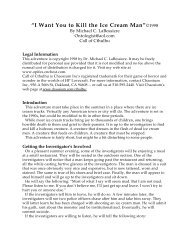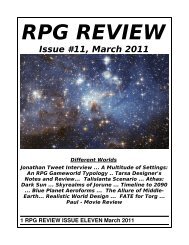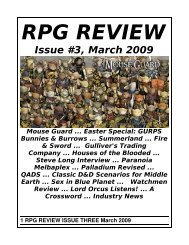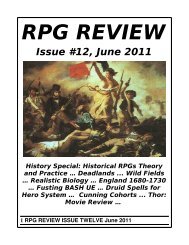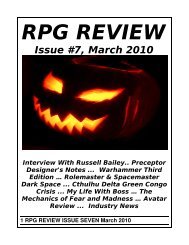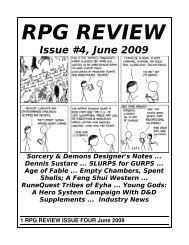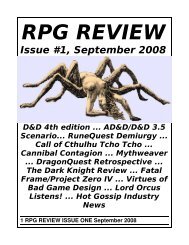seventeenth issue - RPG Review
seventeenth issue - RPG Review
seventeenth issue - RPG Review
You also want an ePaper? Increase the reach of your titles
YUMPU automatically turns print PDFs into web optimized ePapers that Google loves.
A lot of realistic features of GURPS are derived from the attribute levels in a linear manner. Encumberance capacity is<br />
based as a direct function of Strength, and has quick reductions in speed (itself a function of Dexterity and Health), but<br />
a high overall potential. Likewise the capacity to lift, throw, dig, jump, climb, perceive etc. It is obviously unsurprising<br />
to discover a direct relationship between Strength and damage as well, although the game distinguishes between<br />
"swinging" damage and "thrusting" damage. These ratings are applied directly to weapons, so instead of a the weapon<br />
forming the base damage roll, modified by Strength, as is common in many games, GURPS starts with Strength and is<br />
modified by the weapon, which acts as a lever or focussed point. Weapon damage is further modified by the damage<br />
type; impaling, slashing etc. The most dangerous weapons are swung and piercing (e.g., a pick) and the least are thrust<br />
and crushing damage (e.g., a punch). Ranged weapons have an incremental negative on skill resolution and a halfdamage<br />
range.<br />
As mentioned in the introduction the combat system is modular, although that is hardly sufficient itself to justify the<br />
claim of being generic. Broadly speaking however, the core differences between the basic and the advanced combat<br />
systems is that the latter concerns itself with hexbased movement, reach of weapons, hit locations, and close combat.<br />
The secondbysecond combat turn, which particularly allows for realistic action times, has an inititive based on<br />
character speed. On their turn characters are entitled to select from a widerange of actions, which include important<br />
tactical choices (e.g., do you risk all and go for an alloutattack but lose active defenses?), which is always a good<br />
feature. Defenses are either passive (e.g., armour) or active (dodge, parry, or block). The combination of active and<br />
passive defenses equate with a total defense which is rolled against a successful hit. Thus there is up to three rolls for<br />
every turn (attack, defense, and damage) which is fairly average for resolution speed.<br />
After armour reduces rolled damage, the effects of varies significantly by location and type; a piercing blow to the<br />
vitals or brain is absolutely devastating, and a lot less disconcerting to a limb. Breakpoints exist for crippled or<br />
permanently damaged limbs, for being stunned, knocked out, or knocked down. Once characters are brought to less<br />
than hit points they become unconscious. At negative hit points, the character must roll against HT or die and for<br />
every 5 hit points thereafter up to 5*HT, when death is automatic. Healing depends significantly on technology level<br />
and the availablility of skilled medical staff. As a correlate to injury, there is also the accumulation of fatigue, based on<br />
Strength rather than Health. This is acquired through overexertion (e.g., battle), longdistance marching or running,<br />
spellcasting etc.<br />
Finally, GURPS 1st and 2nd editions concluded with brief descriptions of running the game (good advice, logical, but<br />
nothing particularly special), game worlds and especially technology levels (arbitrarily chosen), and a few pages on<br />
special characteristics of animals, albeit with very few examples themselves. Of particular note is character<br />
development, where additional character points are awarded for narrative contributions (to be applied to the<br />
simulationist character), but with the realistic option of learning by training or work. Some of the major and unexpected<br />
gaps included at least a somewhat more comprehensive selection of animals, and equipment.<br />
GURPS 3rd Edition<br />
The third edition of GURPS was released a mere year after the prior edition three editions in three years 1986, 1987,<br />
1988. Originally in a softback, it really reached its height with the revised hardback edition. Whilst in one sense the<br />
release of three editions in as many years was a sign of a fast and popular developing gamesystem (RuneQuest, for<br />
example, had a fairly rapid succession between first, second, and third editions too), this was becoming a little hard to<br />
keep up with. In a delightful move, SJG released "GURPS Update" which included pretty much all of the changes from<br />
34 <strong>RPG</strong> REVIEW ISSUE SEVENTEEN September 2012






